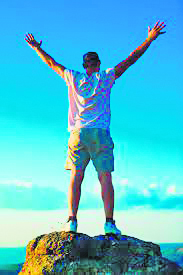
Fear (Bhaya) is an emotion that results from the belief that something or someone is hazardous and is likely to induce pain or discomfort. The operative word in this conceptualization is that it is a belief or a perception that may not be factual. It is a hindrance on the spiritual path as well as everyday life. For some of us, it has become a habit to over-assess the negative outcomes and thus we develop fears. Such a disposition is often associated with pessimism.
Martin Seligman, (1942-present), a contemporary American psychologist, has extensive work with positive psychology and what he calls “learned optimism” as a replacement for “learned helplessness.” If someone looks at the possibility of occurrence of negative events in their least threatening fashion, as being temporary, as being conquerable, as challenges rather than threats then that disposition is called an optimistic style. The pessimists often attribute bad events as their faults; believe that they are likely to happen; and that they have a permanency. While the optimists think that adverse happenings are confined only to a single case, that setback is not their fault and instead, circumstances cause bad events to happen. Seligman’s research shows that optimists do better in life, and they have better health than pessimists. He further says that optimism can be inculcated and learned just like any other skill. These skills help in shifting the paradigm from one of helplessness to one of greater personal control over fears. Helplessness is the “giving up reaction” or the response to quit. While many things in life are beyond our control many more are also within our control and our ability to fight fears is one such thing that is within our control. If we indulge in dwelling on our fears, we will find that they become self-fulfilling. He further emphasizes not blind optimism but a “flexible optimism” that is based on making hopeful choices available to us in overpowering our fears which may be adapted according to the situations.
A method developed by Sri G. V.Vethathiri (1911-2006), an Indian philosopher, in Simplified Kundalini Yoga (SKY), is to classify our fears or worries into four categories: to be faced, to be solved immediately, to be postponed and to be ignored. Fears or worries to be faced include things like death, disability, or other happenings that cannot be changed. Fears or worries to be solved immediately include events like sickness for which immediate treatment is needed, debt that needs to be repaid as soon as possible, and things like that. Fears or worries that need to be postponed include things for which there is no immediacy such as if one has reached the age of marriage and is not able to find a suitable match or worrying about retirement for a young person or other such events. Finally, are the fears or worries to be ignored that include trivial matters regarding which we have simply made it a habit to be fearful? Classifying worries or fears into such categorization reduces the number to a manageable few and helps in facing the important ones that need to be tackled.
Another approach from the Eastern paradigm is written in Isa Upanishad, “Who sees all beings in his own self, and his own self in all beings loses all fear.” Such a model that perceives oneness in human existence and oneness within oneself creates a harmonious perspective and fears are automatically reduced. Having faith in the functioning of the Universe and maintaining a sense of acceptance or faith in that grand scheme of things is often very helpful in overcoming fears.
Dr. Manoj Sharma is a Professor and Chair of the Department of Social and Behavioral Health at the University of Nevada, Las Vegas, USA. He is an avid practitioner of Kundalini Yoga.